Pentax lanserar Optio WS80, en digital vattentät kompaktkamera med låg vikt, idealisk för daglig användning och vid olika utomhusaktiviteter.
 I sitt kompakta kamerahus erbjuder Optio WS80 ett antal avancerade och användarvänliga funktioner. Dessa inkluderar: högupplösta bilder av hög kvalitet tack vare 10,0 effektiva megapixel, 5X optiskt zoomobjektiv, 2,7 tum stor LCD-skärm, video i HD-format och toppmodern ansiktsigenkänning. Det lufttäta kamerahuset möjliggör även undervattensfotografering på ned till 1,5 meters djup.
I sitt kompakta kamerahus erbjuder Optio WS80 ett antal avancerade och användarvänliga funktioner. Dessa inkluderar: högupplösta bilder av hög kvalitet tack vare 10,0 effektiva megapixel, 5X optiskt zoomobjektiv, 2,7 tum stor LCD-skärm, video i HD-format och toppmodern ansiktsigenkänning. Det lufttäta kamerahuset möjliggör även undervattensfotografering på ned till 1,5 meters djup.
”Detta eliminerar alla de problem som kan uppstå i situationer där vatten eller smuts kan bli till ett bekymmer, som vid användning i fuktiga eller dammiga miljöer”, säger Per Skog hos Focus Trading, Pentax svenska generalagent.
Viktiga egenskaper
1. Vattentät för bekymmersfri undervattensfotografering. Trots sitt kompakta kamerahus möter Optio WS80 kraven enligt IPX 8-standarden (eller JIS Class 8), vilket möjliggör undervattensfotografering på ett djup på ned till 1,5 meter under upp till två timmars tid. Den har även Pentax vattenavvisande SP (Super Protect) ytbehandling på objektivts frontlins. Därmed kan kameran enkelt rengöras med färskvatten om den täcks med smuts eller sand. Kameran är även dammtät enligt standarden JIS Class 6.
2. Snabb ansiktsigenkänning. Avancerad ansiktsigenkänning (AF&AE) är en användarvänlig funktion som inte bara fångar upp till 32 ansikten i skarpt fokus och med perfekt exponering på endast 0,03 sekunder, utan även på ett exakt sätt kan detektera motiv som inte vänder ansiktet rakt mot kameran, eller som lutar huvudet. Bland andra användarvänliga funktioner finns Small Face filter, vilket gör att motivets ansikte framstår som mindre i proportion till kroppen, för att producera attraktiva och välbalanserade porträtt, Smile Capture utlöser automatiskt kameran i samma ögonblick som den detekterar ett leende hos motivet, och blinkdetektering varnar fotografen om motivet råkar sluta ögonen i tagningsögonblicket.
3. Högpresterande 5X optisk zoomobjektiv. Trots sina kompakt mått har Optio WS80 ett 5X optiskt zoomobjektiv med en brännvidd motsvarande 35 till 175 mm i 35 mm format. Det finns även Intelligent Zoom, en funktion som utökar zoomomfånget med upp till 28,5 gånger för ännu längre inzoomning på motivet.
4. Tredubbel bildstabilisering
1) Pixel Track SR Vid tagning av stillbilder kompenserar kamerans bildstabilisering på ett effektivt sätt för kameraskakningar genom att bearbeta berörda bilder.
2) High Sensivity SR: Vid stillbildstagning i svaga ljusförhållanden ökas känsligheten automatiskt ända upp till ISO 6400, vilket gör det möjligt att använda högre slutarhastigheter.
3) Film SR: Vid filminspelning förhindras oskärpa med hjälp av en avancerad mjukvara.
5. Filminspelning i HD-format. Optio WS80 tar fulländade filmklipp i 16:9 HDTV-proportioner (1280×720 pixlar) med 30 bildrutor per sekund. Vidare finns automatisk optimering av kamerainställningar vid undervattensfilmning.
6. Hög bildkvalitet. Kombinationen av 10,0 effektiva megapixel med Pentax processor och zoomobjektiv ger briljanta högkvalitativa bilder med väldefinierade detaljer. Även när bilder förstoras till storformat garanteras skarpa kopior med bra kantskärpa.
7. Stor 2,7 tums LCD-skärm för smidig bild/meny-visning. Sitt kompakta kamerahus till trots har Optio WS80 en stor och ljusstark 2,7 tums färgskärm med ca 230 000 bildpunkter, för tydliga menyer och smidig bildgranskning.
8. Fler funktioner
a) Intervallfotografering, av exempelvis moln i rörelse eller blommor
b) Snabbt AF-system med Auto-Track för fokusering på motiv i rörelse
c) Automatiskt val mellan åtta olika fotograferingslägen för optimalt resultat
d) Olika digitala filter, däribland leksakskamera och retro, för spännande visuella effekter
e) D-Range, förhindrar över- och underexponerade områden i bilder
f) Digital Wide, skapar panoramabilder från två bilder (motsvarande en bild tagen med ett 25,4 mm objektiv i 35 mm format)
g) Digital panorama, skapar en panoramabild av två eller tre bilder
h) Style Watch, visar tiden med knapptryckning, även när kameran är avstängd
i) Återställning av raderade bilder
j) 90 dekorativa ramar att infogas vid fotografering eller i efterhand
Pris 2 599 kr.
Länk: www.focustrading.se
För första gången på 15 år avgörs ett vindsurfing-VM i Sverige. Den 13 -16 augusti arrangeras årets VM i Kona-klassen i Motala. De svenska medaljförhoppningarna är stora i denna snabbt växande breddklass. Regerande världsmästare är svenske Björn Holm. Han hör också till en av årets favoriter där han får hård konkurrens av sin blott 15-årige son Adam som ligger etta på juniorrankingen i världen.
– Vi är enormt glada och stolta över att få arrangera detta VM och en möjlighet att visa upp vindsurfing för en bredare publik i Sverige. Tävlingssegling har mer och mer utvecklats till en sport för folk med mycket pengar. Vi vill vara ett alternativ till detta, säger Joachim Larsson från svenska Kona One-förbundet och ansvarig för tävlingarna.
Tävlingarna kommer att avgöras på Vättern vid Varamon utanför Motala och har samlat ett rekorddeltagande. Totalt kommer 90 deltagare från 10 länder att göra upp om VM-titlarna i herr-, dam- och juniorklassen. En av de anmälda är den 65-årige legendaren Bruce Matlack som 1972 vann det allra första världsmästerskapet i vindsurfing.
Vid förra årets VM i Tyskland segrade svenske Björn Holm som funnits med i tävlings sammanhang inom vindsurfing sedan 1980-talet. Han slutade också på silverplats vid årets SM tätt före sin son, 15-årige Adam Holm, som är Sveriges bäste junior och som har siktet inställt på nästa års ungdoms-OS.
– SM var sista gången som pappa slog mig. På VM kommer jag att segla ifrån honom, lovar Adam Holm.
Vindsurfingen föddes i Kalifornien i slutet av 1960-talet. Till Sverige kom sporten i mitten av 1970-talet och utvecklades under de följande åren till en verklig folksport. Det blev en sport för alla i familjen, för unga och gamla, för proffs och amatörer. I mitten av 1980-talet samlade också vindsurfingens eget Vasalopp, VKV-brädan i Västerås, nästan 1 000 deltagare. Under de 20 senaste åren har dock vindsurfingen gått i en mer och mer extrem riktning med allt mer och dyrare utrustning.
– Kona innebär tillbaka till rötterna. En bräda och ett segel anpassat efter vikt och ålder. I våra tävlingar kan alla vara med. Det är därför som vår form av vindsurfing har blivit så otroligt populär i Sverige på kort tid, menar Joachim Larsson.
Tävlingarna arrangeras av Motala Segelsällskap tillsammans med Svenska Kona One-förbundet.
Länk: www.bradsegla.se
Tjörn Runt är den segeltävling där världsmästare och familjeseglare samsas på samma vatten och tävlar under samma förhållanden. 28 sjömil skall seglas. Deltar gör alla typer av båtar; från den minsta kölbåt till den största. Första start går kl. 08:50.
I årets startfält av Tjörn Runt är hittills 531 båtar anmälda. Efteranmälan kan göras under fredagen och vi räknar med ytterligare ett 20-tal deltagare.
Årets stjärnor
OneOffracern Toyota styrs av den nyblivne europamästaren i matchracing, Johnie Berntsson, 100-fotaren Hyunduai har legendaren Pelle Petersson vid rodret. Jonas Berntsson, nybliven svensk mästare i 606 seglar Melges. Anders Dahlsjö, nyss hemkommen från Ericsson 3 i Volvo Ocean Race, vann Tjörn Runt 2004 i Dominant 105 och är med och slåss i år igen. Hans Oskarsson vann 2006 i Accenten Oscar, Bengt Falkenberg vann 2003 och vill göra om det i First 45. Mikael Collberg har vunnit Tjörn Runt tre gånger, han seglar Cumulus i år. Emil Sandberg har vunnit Tjörn Runt två gånger och är still going strong i Smaragd. Och Mats Johansson i Starbåt vann Tjörn Runt för andra gången 2008. Han vill gärna upprepa den segern.
Draken SE 249 “Mathilda” byggd 1948 och seglad första säsongen 1949 firar 60-årsjubileum med rorsman Jerry Burman, Världsmästare i Drake 1973, samt besättningen Daniel Nilsson och Caroline Averius.
De båttyper som samlar 10 deltagare tävlar även om egna priser.
Express 28 deltagare, H-båt 20, Maxi 77 16, Cumulus 12, Smaragd 11, X-99 (8 st.) samt X99 11 är några av dem som är med och tävlar om egna klasspriser.
I samtliga klasser har antalet båtar ökat från föregående år.
Länk: www.stss.nu
Fredagen den 14 augusti 2009 kommer Josefine Svahn, 12 år från Stenungsunds Segelsällskap (StSS), som första seglare med rörelsehinder, att delta i Lilla Tjörn Runt i en Access-jolle.
Assisterande i samma båt under Lilla Tjörn Runt 2009 är Karolina Berglund som är StSS huvudinstruktör för både den vanliga seg¬lar¬skolan och seglar¬skolan för barn med funktionsnedsättning.
Ännu finns ingen egen klass för Access-jollen, som är en australiensisk jolle, konstruerad för att göra segling okomplicerad och lättillgänglig.
Stenungsunds Segelsällskap (StSS) har satsat på segling för funktionshindrade och genomförde nu i sommar sin tredje seglarskola i samarbete med Rotary i Stenungsund.
Många barn har fått möjlighet att pröva på segling med Access-jollen. Att segla med Access-jollen ger dem möjlighet att klara av något på egen hand, vilket är en utmaning som ger både ökat självförtroende och frihetskänsla.
Genom att delta i Lilla Tjörn Runt 2009 hoppas StSS att flera barn med funktionsned¬sätt¬ning och föräldrar till barn med funktionsnedsättning skall få upp ögonen att prova på segling som stimulerar både kropp och själ. Även GKSS deltar med två Access-jollar.
Bilden:
Josefine Svahn närmast kameran och Karolina Berglund i bakgrunden. Utmärkande för båten är ett tungt barlastcenterbord, breda däck, bekväm och djup sits och joystick som fungerar som rorkult. Access-jollen upplevs som mycket stabil och lättseglad.
Länk: www.stss.nu
STOCKHOLM, 11 augusti 2009 – Det är dags för nionde upplagan av Archipelago Raid – den största och mest extrema seglingsorienteringstävlingen i världen. Från måndag 17 augusti ska cirka 30 team under sex dygn orientera sig fram genom Stockholms, Ålands och Finlands skärgård, i ett kraftprov där komplicerad navigering och för lite sömn är problem som måste övervinnas.
I år avgörs tävlingen för nionde gången med start 17 augusti och målgång 22 augusti. Start och mål sker på kursgården At Sea på Lidingö utanför Stockholm. Banan går genom Stockholms skärgård, via Åland, till skärgården utanför finska Åbo och tillbaka igen. Båtarna är Formula 18-katamaraner vilket är små (5,5 meter) mycket snabba båtar med två skrov.
Det som gör tävlingen unik och annorlunda är att deltagarna ska orientera sig fram genom skärgården. De får cirka 20-25 checkpoints (två koordinater) som ska passeras och får själva välja den väg som de tror går snabbast. Kontrollerna kan finnas på en strand, på en brygga, i en fyr, etc. Tanken med tävlingen är att den ska vara både mentalt och fysiskt påfrestande. Därför seglas det både på dagar och på nätter. Ibland finns kortare vilostunder inlagda, men då har besättningarna ofta justeringar eller mindre service att utföra på båtarna. Skulle de få en lite möjlighet att sova, så sker det oftast under bar himmel.
Tack vara den unika tävlingsformen och den vackra skärgården har Archipelago Raid vuxit till en stor och framför allt respekterad tävling bland namnkunniga kappseglare från hela världen. I år har cirka 30 team från 13 länder anmält sig. Bland deltagarna finns Anders Lewander som var skeppare ombord på Ericsson 3 under delar av Volvo Ocean Race. OS-seglaren och svenske mästaren i F18, Martin Strandberg, är med. Finske OS-guldmedaljören och rorsman på Ericsson 3, Thomas Johanson, deltar. Gustav Morin, som var medieman ombord på Ericsson 3 i Volvo Ocean Race, kommer också.
Länk: www.archipelagoraid.com
Foto: Thierry Martinez.
Powerboat P1 har beslutat att de bensindrivna tävlings- och funktionärsbåtarna vid Havets Grand Prix i Göteborg 7-9 augusti ska använda miljöanpassat bränsle från Lantmännen Aspen i Hindås utanför Göteborg. Aspen+ alkylatbensin används redan inom bilsportens STCC-serie och är renad från skadliga ämnen som bensen, polyaromatiska kolväten, olefiner och aromatiska kolväten.
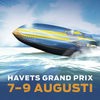 I linje med internationella båtsportförbundet UIMs riktlinjer om att uppmuntra miljöanpassat beteende och teknik, minskar Aspen+ utsläppen till både vatten och luft samtidigt som bensininnehållet blir renare. Aspen+ minskar bildandet av marknära ozon med över 50 procent.
I linje med internationella båtsportförbundet UIMs riktlinjer om att uppmuntra miljöanpassat beteende och teknik, minskar Aspen+ utsläppen till både vatten och luft samtidigt som bensininnehållet blir renare. Aspen+ minskar bildandet av marknära ozon med över 50 procent.
Aspen alkylatbensin innehåller 99 procent färre skadliga ämnen än vanlig bensin. Andelen aromatiska hydrokarboner är 0,1 procent mot 35 procent i vanlig bensin. Alkylatbensinen släpper ut mindre avgaser och lukt samt ger lägre sotbildning i förbränningsrummet.
Nyligen gjorda tester i Cosworths motorlab i England gav positiva resultat och Asif Rangoonwala, ordförande och VD i Powerboat P1 är övertygad om att detta är ett miljömässigt genombrott för VM-serien.
– Detta är en märkesdag för Powerboat P1, säger han. Vi har många spännande planer för 2010 – nya tävlingsorter, nya team och nya partners – och jag hoppas att vi genom att ha Aspen ombord på vårt första besök i Skandinavien visar hur seriöst vi ser på arbetet för en grönare framtid.
– Det finns en ökande medvetenhet inom motorsporten för miljöfrågorna och Powerboat P1 har utvecklat en miljöpolicy och vi håller på att introducera ett miljöprogram som en integrerad del av vår affärsstrategi. Genom att låta Aspen driva våra tävlings- och funktionärsbåtar i Sverige visar vi att vi menar allvar med vårt engagemang för en grönare framtid.
Mario Hytten, arrangör av Havets Grand Prix, instämmer och tillägger:
– Vi hoppas att alla Powerboat P1-tävlingar kommer att köra helt på etanol inom två-tre år. Det skulle vara kul att då kunna se tillbaka och säga “det började i Göteborg 2009”.
Sedan starten 1988 har Lantmännen Aspen utvecklat en stark kundbas i 15 länder med en försäljning på sammanlagt 100 miljoner liter. Mats Uhrlander, nordisk marknads- och försäljningschef på Aspen stödjer Rangoonwalas vision för Powerboat P1 till 100 procent.
– Detta är ett nytt samarbete för Aspen, säger han. Att arbeta med Powerboat P1 har gett oss möjligheter att minska utsläppen i vattnet utanför Göteborg 300 gånger. Det är också en stor utmaning för oss att visa att Aspen+ miljöanpassade alkylatbensin går hand i hand med racing på toppnivå.
Svenska livräddningssällskapets, SLS, preliminära sammanställning över omkomna genom drunkning visar att 18 personer omkom genom drunkning under juli i år jämfört med 28 personer under juli 2008.
Totalt har 49 personer omkommit i år genom drunkning jämfört med 68 under samma period under 2008.
2009 Juli 2008 -07 -06 -05 -04 -03 11 fritidsbåt 5
4 bad 15
3 övriga 8
18 totalt 28 17 47 26 24 37
Under juli 2008 omkom 15 personer vid badolyckor medan det under juli i år omkom 4 personer i samband med bad. Det regniga vädret i stora delar av landet gjorde att färre sökte sig till stränderna för att bada.
Det omvända förhållandet kan noteras när det gäller olyckor med fritidsbåtar. Under 2009 har elva personer drunknat i samband med fritidsbåtar mot fem under 2008. Den främsta orsaken till drunkningsolyckorna är man inte använt flytväst.
Under sommarmånaderna juni och juli 2009 har 25 personer omkommit genom drunkning. Det är 12 färre under samma period 2008 då 37 människor omkom. Det lägre antalet 2009 kan till del förklaras med det sämre sommarvädret. Men jämför man med 2007, som uppvisade liknande sommarväder, var antalet då 35 personer. Svenska livräddningssällskapet vill gärna tolka minskningen med att fler vet om riskerna med bad och fritidsbåtar och att man anpassar sitt uppträdande efter detta.
De sex män som saknas efter olyckan med det norska fartyget Langeland den 31/7 i Kosterfjorden ingår inte i den redovisade statistiken.
Sammanställning 1994 – 2009
Antal omkomna genom drunkning under juni – juli
juni juli totalt året totalt
t.o.m juli hela året
1994 23 50 123 176
1995 20 42 111 175
1996 12 16 60 111
1997 12 34 87 163
1998 13 24 82 154
1999 22 21 90 128
2000 13 19 88 134
2001 15 24 83 134
2002 14 21 73 149
2003 12 37 97 134
2004 17 24 81 119
2005 11 26 71 107
2006 19 47 91 135
2007 18 17 65 103
2008 9 28 68 107
2009 7 18 49 –
Genomsnitt för de
senaste 10 åren 14 26 77
Lördagen den 15 augusti arrangerar Stenungsunds Segelsällskap den klassiska seglingstävlingen Tjörn Runt för 46:e gången. Här samsas olympiska mästare med glada amatörer på lika villkor – totalt är över 500 båtar anmälda till denna traditionsenliga folkfest.
Arrangemangen kring seglingarna utgår från Stenungsbaden Yacht Club, där man inleder uppladdningen redan på fredagseftermiddagen med skepparträffar. Tidigare under dagen genomförs dessutom Lilla Tjörn Runt, som numera är Nordens största tävling för optimistjollar, med nära fyrahundra anmälda juniorseglare i alla årsklasser.
Första start på lördagen går kl 8:50 utanför Stenungsön, med målgång i den inre delen av Stigfjorden. Båda dagarna ger såväl den mångtusenhövdade publiken och alla deltagarna gott om tillfällen att koppla av, med ett digert underhållningsprogram.
– På fredagen laddar vi upp med CC&Lee, Magnus Carlsson och Partypatrullen, medan lördagens regattafest med prisutdelningsmiddag följs av dans till Sound Express och Rock of the Eighties med Mats Livén och Partypatrullen, berättar Karin Åkerman som är marknadschef på Stenungsbaden Yacht Club.
Just Karin Åkerman återfinns denna gång även som tävlande – i en renodlad tjejbåt!
– Ja, vi är ett nätverkande kompisgäng från traktens näringsliv som bestämt oss för att ställa upp bara för att det är så kul – och förstås för att skapa lite extra uppmärksamhet för tävlingarna, berättar Karin vidare. Övriga i gängets Bavaria 50-fotare är Sanna Hermansson från Salt & Sill, Britta Stolt från Rederi AB Transatlantic, Liselott Kantling från Stenungsunds segelsällskap och frilansfotografen Lisa Nestorson.
Länk: www.stss.se
Fotograf: Lisa Nestorson.
De senaste dagarnas fartygsolyckor och oljeutsläpp utanför Norges och Sveriges kuster understryker behovet av hårdare kontroll av sjöfarten.
– Vi har varit en hårsmån från en allvarlig miljöolycka i Sveriges första blivande marina nationalpark, Kosterfjorden, som invigs i september. Nu krävs skärpta regler och rutiner för att skydda känsliga havs- och kustmiljöer, säger WWFs generalsekreterare Lasse Gustavsson.
Hittills har mer än 200 ton bunkerolja läckt ut från det Panama-registrerade lastfartyget Full City som i fredags gick på grund i norska Skagerrak några mil från Strömstad. Samtidigt ligger det norska fartyget Langeland förlist i ett av Sveriges mest artrika och värdefulla kustområde söder om Kosteröarna.
För att förhindra ytterligare oljeutsläpp och olyckor i framtiden krävs en ökad kontroll av sjöfarten, menar WWF. Några krav som regeringen bör arbeta för är:
• Ökad hänsyn till viktiga och känsliga naturområden, rev, broar, vindkraftverk mm. vid planering av sjötrafikleder
• Särskilda fartygsleder för tung sjöfart,
• Bemannad bevakning som kan anropa fartyg
• Nya initiativ för att gynna kvalitetssjöfart gentemot undermåliga fartyg, till exempel lotsplikt för fartyg med otillräcklig kompetens eller utrustning
– Många av åtgärderna för att förbättra situationen måste göras på internationell nivå via den internationella sjöfartsorganisationen IMO. Men andra kan lösas regionalt av länderna kring Östersjön, Skagerrak och Kattegatt. Estland, Finland och Ryssland har gemensamt kommit långt genom att införa trafikledningssystem som drastiskt minskat olyckorna i Finska viken. Nu måste övriga länder i regionen inse att det är dags att agera, säger Lasse Gustavsson.
– Sjötrafikleder och bemannad övervakning skulle minska olycksrisken drastiskt, säger Mattias Rust, sjöfartshandläggare på WWF. Redan 2004 gick WWF och Redarföreningen gemensamt ut med krav om säkrare sjöfartstransporter. Eftersom mycket lite har hänt sedan dess,förutom fler allvarliga olyckor, är frågorna än mer aktuella idag.
Saneringen av olja utanför norska kusten och tvättning av oljeskadade sjöfåglar har pågått nu för fullt hela veckan. WWF i Norge bistår med ett 70-tal volontärer som gör detta arbete.
SNAV OSG, som körs av Hannes Bohinc och Giancarlo Cangiano, säkrade sin fjärde vinst för säsongen genom att på lördagen vinna Göteborgs sprint race, vilket förde OSG Team ett steg närmare världsmästartiteln i Powerboat P1.
Bohinc och Cangiano kämpade mot bland andra utmaningen Lucas Oil Outerlimit från USA, körd av Joe Sgro och Nigel Hook. Efter två tredjedelar av racet med bara tre varv kvar avgjordes dock deltävlingen.
Det var i stort sett plattvatten vid tävlingen och därför gick det undan ordentligt på vattnen utanför Göteborg. Båten Cigarette Smash Poker med Luca Fendi och Matteo Nicolini kom in på andra plats med Lucas Oils Outerlimits som trea. Ledaren av världsmästerskapserien, Silverline, körd av Drew Langdon och Jan Falkowski, slutade på fjärde plats, ett varv efter.
Fortfarande återstår ett race för fyra båtar på lördagen. Sträckan de ska köra är 73 Nm.
Scandinavian Grand Prix of the Sea (Round 7)
Sprint Race Result– Evolution Class
1– 88 – SNAV OSG – IT – 33:05.34 – 100
2 – 10 – Cigarette Smash Poker – IT – 33:44.08 – 90
3 – 77 – Lucas Oil Outerlimits – USA – 35:08.37 – 81
4 – 47 – Silverline – GBR – 33:39.09 – 73 ( 1lap down)
DNF – 66 – Cranefields Wine – DE
DNF – 33 – Furnibo – BEL
2009 Powerboat P1 World Championship
Standings after 7 rounds – Evolution Class
1 – 47 – Silverline – GBR – 573
2 – 88 – SNAV OSG – IT – 481
3 – 10 – Cigarette Smash Poker – IT – 461
4 – 77 – Lucas Oil Budweiser – USA – 419
5 – 33 – Furnibo – BEL – 270
6 – 66 – Cranefields Wine – DE – 209
7 – 53 – Metamarine – IT – 162
Länk: www.hannesbohinc.com/p1
Den försvarande Europamästaren i havskappsegling, Ralf Aspholm, slutade tvåa i Ystads EM-tävling med sin 40-fotsbåt DataCom. – Vi ledde fram till sista kappseglingen den sista dagen och var otroligt nära att försvara vår EM-titel, säger Ralf Aspholm.
Det kombinerade SM och EM i havskappsegling som gick av stapeln i Ystad i veckan vanns av den tyska skepparen Christian Plump med båten Beluga Sailing. Ralf Aspholm ledde tävlingen under hela veckan men marginalen till tvåan inför sista dagens segling var liten.
När Beluga Sailing vann den avslutande bankappseglingen och DataCom seglade in som åtta kunde den tyska båten smita förbi och knipa Europamästerskapet.
– Det avslutande racet var otroligt tight med minimala marginaler. Vi gjorde inga egentliga misstag på vattnet men de hade mycket bra fart i båten och manövrerade den närmast felfritt, berättar Ralf Aspholm.
Ystads Offshore Week 2009 har bjudit på många jämna seglingar mellan Europas bästa seglare. Enligt Ralf har förutsättningarna varit bra:
– Vi har haft mycket bra förhållanden för kappsegling, bra vatten, bra väder och en välorganiserad tävling från Ystad SS sida. Vi på DataCom har seglat på hög nivå hela tävlingen och är mycket nöjda med vår prestation, även om vi föll lite på målsnöret, berättar Ralf Aspholm.
Svenske seglaren Martin Nilsson slutade totaltrea med sin båt Capio. Bland de sju bästa båtarna finns totalt fem svenska skeppare.
Slutresultat Ystad Offshore Week 2009
1 BELUGA SAILING Christian Plump GER
2 DATACOM Ralf Aspholm SWE
3 CAPIO Martin Nilsson SWE
4 LEXUS Jani Lehti FIN
5 DU SOLEIL II Ingvar Hertzman SWE
6 REPLAY Ola Sandell SWE
7 BIRGITTA Anders Helmrich SWE
8 PATENT3 Jürgen Klinghardt GER
9 XANTHIPPE John Hatch NOR
10 SILVA-HISPANIOL Dennis Gehrlein GER
Trots ett tillfälligt stopp på det tionde varvet efter en dramatisk spin av en av tätbåtarna kunde Hannes Bohinc och Giancarlo Cangiano säkra en tredje Grand Prix seger för OSG Racing vid Powerboat P1 Scandinavian Grand Prix i Göteborg. De följde upp lördagens vinst med en andraplats i dagens 74 Nm långa uthållighetstävlingoch tog ett steg närmare VM-titeln med bara två race kvar.
Efter ett spännande race mellan främst tre båtar ledde belgiska Furnibo från Belgian 2B1 Racing team in i första svängen, tätt följd av amerikanska Lucas Oil Outerlimits och SNAV OSG. Tävlingen fortsatte med hög dramatik och hastigheter på över 100 knop.
Outerlimits powerboat med Joe Sgro och Nigel Hook tog in på de tre ledarbåtarna, men flippade över på taket och började sjunka. Tävlingen stoppades omedelbart medan förarna räddades ur vattnet och båda fördes till sjukhus. Därefter startades tävlingen om.
De båda personerna som föll i vattnet var endast lindrigt skadade. Enligt uppgifter i Göteborgs-Posten höll båten cirka 70 knop vid olyckastillfället. Den körde troligen in i vågsvallet från en annan båt.
Belgiska och Mercury-försedda Fountain med piloterna Frank Hemelaer och Pierre Colpin fortsatte i ledning med SNAV OSG på andra plats och Cigarette Smash Poker som tera. Bohinc och Cangiano kunde dock inte ta in mer utan slutade tvåa.
Nu åker teamen vidare till nästa deltävling, som hålls på Sicilien 12-13 september.
Foto: onEdition.
Scandinavian Grand Prix of the Sea – Overall Result
Evolution Class
1– 88 – SNAV OSG – IT – 181
2 – 10 – Cigarette Smash Poker – IT – 171
3 – 47 – Silverline – GBR – 146
4 – 33 – Furnibo – BEL – 100
5 – 77 – Lucas Oil Outerlimits – USA – 81
6 – 66 – Cranefields Wine – DE – 0
Scandinavian Grand Prix of the Sea (Round 8)
Endurance Race Result– Evolution Class
1– 33 – Furnibo – BEL -100
2 – 88 – SNAV OSG – IT – 90
3 – 10 – Cigarette Smash Poker – IT – 81
4 – 47 – Silverline – GBR – 73
DNF – 77 – Lucas Oil Outerlimits – USA
DNF – 66 – Cranefields Wine – DE
2009 Powerboat P1 World Championship
Standings after 8 rounds – Evolution Class
1 – 47 – Silverline – GBR – 646
2 – 88 – SNAV OSG – IT – 571
3 – 10 – Cigarette Smash Poker – IT – 532
4 – 77 – Lucas Oil Budweiser – USA – 418
5 – 33 – Furnibo – BEL – 370
6 – 66 – Cranefields Wine – DE – 205
7 – 53 – Metamarine – IT – 202
Länk: www.hannesbohinc.com/p1
Hannes Bohinc och Giancarlo Cangiano slutade tvåa bakom den belgiska båten Furnibo vid fredagseftermiddagens inledande race för PowerPole för Scandinavian Grand Prix of the Sea. – Båten uppför sig mycket väl och vi har farten för att kunna vara med och tävla i den absoluta toppen, säger Bohinc, 2005 års P1 världsmästare.
– I morgon är en avgörande dag för teamet och vi måste vara med från start för att ha en chans att vinna.
Starten av dagens race, där den första sträckan är på 3 Nm ut till första bojen, kan mycket väl avgöras av hur båtarna tar sig ut ur första svängen. Den Mercury-försedda Outerlimits, SNAV OSG, får hårt motständ från det belgiska teamet och den italienska Cigarettebåten. Väderförutsägelserna säger plattvatten, vilket gynnar ett mycket snabbt race.
Ledarna av Evolution Championship, Silverline, misslyckades i PowerPole på grund av att backslaget gick sönder tidigt i racet.
Powerpole Result- Evolution Class
1 – 33 – Furnibo –Bel –
2 – 88 – SNAV OSG – IT –
3 – 10 – Cigarette Smash Poker – IT –
DNF – 47 – Silverline – GBR – DNF
DNS – 77 – Lucas Oil Outerlimits – USA –
DNS – 66 – Cranefields Wine – DE
Länk: ://www.wettpunktracing.com/p1
Foto: onEdition.
När Ola Skinnarmo och hans besättning lämnade Murmansk har de redan seglat 3000 sjömil. Trots det är expeditionen bara halvvägs. Och nu börjar äventyret på riktigt. — De ryska experterna ger oss 50 procents chans att klara oss igenom isen, säger Ola Skinnarmo från Murmansk.
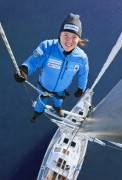 in vana trogen följer Ola Skinnarmo en historisk äventyrare i fotspåren och försöker med denna expedition att upprepa Nordenskiölds bragd; att segla Nordostpassagen. Och även om expeditionen tills nu varit lyckad är det långt ifrån säkert att man kommer att lyckas. En kall vinter och en sen vår gör att det finns stora ismassor kvar.
in vana trogen följer Ola Skinnarmo en historisk äventyrare i fotspåren och försöker med denna expedition att upprepa Nordenskiölds bragd; att segla Nordostpassagen. Och även om expeditionen tills nu varit lyckad är det långt ifrån säkert att man kommer att lyckas. En kall vinter och en sen vår gör att det finns stora ismassor kvar.
— Det är ett av världens tuffaste ställen att segla på. Trots att den globala uppvärmningen har bidragit till att det förra året var rekordlite is är området runt Kap Tjeluskin, gamla värdens nordligaste punkt, fortfarande fullt av is. I det området kommer vi troligtvis få avvakta isen innan vi, om möjligt, kan segla igenom, säger Ola Skinnarmo.
”Allt har gått smidigt”
För Skinnarmos expedition gick inträdet till Ryssland förhållandevis smärtfritt. Den ryska kustbevakningen godkände den svenska segelbåten och på bara två dagar fick man de nödvändiga papperen stämplade. Om man över huvud taget tillåts tillträda ryskt vatten brukar det ta flera veckor att få alla dokument godkända.
— Allt har gått mycket smidigt. Tack vare gott förarbete med den ryska byråkratin och ovärderliga ryska kontakter kan vi nu fortsätta vår expedition, säger Ola Skinnarmo.
Nordostpassagen-expeditionen är ett svenskt-ryskt samarbete, där Ola Skinnarmo har handplockat expeditionsmedlemmarna från både Sverige och Ryssland. Precis som för Nordenskiöld handlar äventyret mycket om kulturutbyte. Teamet ombord dokumenterar utöver miljöförändringar även utvecklingen av regionen och dess unika kultur och människor.
— Jag vill sätta fokus på den globala uppvärmningen och det som händer med miljön i Arktis, säger Ola Skinnarmo.
Äventyraren Nils Adolf Erik Nordenskiöld lyckades med skeppet Vega 1878-1880 bli den första att segla Nordostpassagen. Han bar länge på ett intresse för att utforska möjligheten att färdas från Atlanten till Stilla havet genom att segla norr om Sibirien. Men det hela gick inte smärtfritt till. I tio månader satt Nordenskiöld och hans besättning fast i ismassorna.
Blogg: www.skinnarmo.com
Nu är deltagarna på plats inför årets P1 Powerboat World Championships i Göteborg. Powerboat P1 är världens främsta marina motorsport med deltagare från hela världen och topphastigheter på över 200 km/h i fräcka enskrovsbåtar och katamaraner.
I år komemr teamen i både klass Evolution och klass SuperSport att tävla om titeln i VM i fem deltävlingar, Grand Prix of the Sea i Europa, Asien och Mellanöstern. Detta är den sjunde säsongen som tävlingen arrangeras.
Årets säsong startade i Valetta på Malta den 8 maj och fortsatte därefter till Istanbul i Turkiet (19-21 juni). Därefter åkte båtarna till San Benedetto Del Tronto i Italien (3-5 juli). Efter tävlingarna i Göteborg väntar finalen på italienska Sicilien, som hålls 11-13 september.
Följ deltävlingen i Göteborg på hemsidan.
Länk: www.w-w-i.com/p1_2009/
Foto: onEdition
Roslagsloppet, en svensk och internationell båtsportsklassiker sedan 1960-talet startar imorgon, 8 augusti. Starten i Trälhavet, Österåker, genom Stockholms norra skärgård går en radikal bana mot målet i Öregrund. Loppet följs av tusentals åskådare som i år har möjlighet att addera spänningen med vadslagning på fyra klasser, Offshore 3C, Thundercat, V-150 och V-300.
Förra årets totalsegrare och klassvinnare, Sven Bengtsson Offshore 3C klassen, är favorit till 1,50. Thundercat klassens Rolle Sjögren spelas till urstarka 1,10. I den mer osäkra klassen V-150 segrar Peter Forsberg på det klart spelbara oddset 2,50. Fredrik Zander i V-300 klassen tar hem segern till oddset 1,80.
Ladbrokes sommar i Sverige har varit stekhet med nya spännande spelobjekt på nationell och internationell båtsport och segling. Att göra klassikern Roslagsloppet gör oss störst i Sverige på området, en position vi tänker behålla, säger Andreas Gillberg, Ladbrokes Sverigechef.
Aktuella odds Roslagsloppet:
Offshore 3C
Sven Bengtsson 1.50
Mikael Bengtsson 4.00
Thomas Rosen 7.00
Thomas Wrenkler 11.00
Daniel Segenmark 15.00
Magnus Sjolander 31.00
Roger Soderstrom 51.00
Daniel Svensson 51.00
Thundercat
Rolle Sjogren 1.10
Sigurd Mollestad 6.00
Stefan Myhrberg 15.00
Conny Sjogren 31.00
Micke Forsman 51.00
Oskar Molarin 51.00
Adde Forsman 101
Fredrik Karlsson 101
Johan Lundmark 151
Stefan Rindar 151
V-150
Peter Forsberg 2.50
Peter Wahsltrom 3.00
Mats Endresen 11.00
Linus Johnson 15.00
Hasse Bergqvist 51.00
Tobias Lodin 61.00
Erik Andersson 81.00
Tobias Elisson 101.00
Thomas Johansson 151.00
Jon Palmqvist 201.00
V-300
Fredrik Zander 1.80
Anders Nilsson 2.25
Thomas Fredriksson 10.00
Peter Jobs 21.00
Magnus Pettersson 31.00
Conny Hertz 41.00
Andreas Wirback 51.00
Fredric Soderberg 61.00
Länk: www.ladbrokes.com
Klicka på svenska specialare – Roslagsloppet
Bavaria Cruiser 32 har nominerats till Yacht of the Year 2009/10 i sin klass. Det är en båt med modern funktionell formgivning, enkel hantering, bra prestanda, högsta boendekomfort – allt till ett attraktivt pris.
Båten har tagits fram i samarbete mellan Farr Yacht Design och BMW DesignworksUSA. Farr Yacht Design är erkända som ett av världens främsta yacht designers. BMW DesignworksUSA är ett av världens mest innovativa designkontor.
Bavaria varvet har nyligen presenterat sin ”top of the line” Bavaria Cruiser 55 designad av samma team. Släktskapet med 55:an syns tydligt i den nya båten. Designen är djärv utan att gå för långt. Aldrig tidigare har en 32 fots båt varit så stor.
Nya Cruiser 32 sätter en ny standard för vad det går att få ut av en 32 fots segelbåt. Sittbrunnen är bl.a. tack vare den fällbara badbryggan rekordstor. Ny utformning av rattpedistalen och snillrik lösning av storskotet ger rymd.
Båtens grundform ger stora volymer inombords. Akterhytten är att betrakta som ”ägarhytt” och går att jämföra med dem i 40‐fots båtar. Våtutrymmet är absolut rekord i klassen. Salongen har generös L‐ soffa som i Bavaria 35:an. Extra rymd har skapats genom däckets form och att ytan för navigation minskats. Förpiken är rejäl med bra höjd, fullängdskojer, garderob och hyllskåp.
Seglingsmässigt borgar Farr Yacht Design för de fina egenskaperna. Vid utvecklingsarbetet har företagets representant i Sverige arbetat för enklare segelhantering. Det betyder att 32:an är konstruerad för att seglas med fock i stället för genua. Detta är en segelföring som passar svenska vatten bra.
Den nya 32:an har genomgått ett avancerat utvecklingsarbete. Erfarna industridesigners ser till att varje detalj är noga genomtänkt och funktionen väl analyserad. Båten, men också tillverkningen, planeras noggrant redan i designprocessen. Detta arbete i kombination med varvets högteknologiska tillverkning gör att grundpriset för den nya båten ligger lägre än för föregångaren Bavaria 31 Cruiser.
Data
Längd över allt 9,99 m
Skrov längd 9,80 m
Bredd 3,42
Djup 1,95 / 1,50
Depl. 4,870 kg
Bränsle 150 l
Vatten 150 l
Grund pris fritt varv drygt 700 000 kr.
Länk: www.bavariasverige.se
Baltic Match Race, den svenska deltävlingen i nya Baltic Match Tour, tog ett ovanligt grepp och genomförde en auktion om huvudsponsorskapet för tävlingen. Gill, ett ledande varumärke för tekniska seglingskläder, vann och blir därmed huvudsponsor för Gill Baltic Match Race som avgörs i Stockholm den 14-16 augusti med svenska och internationella toppseglare i matchracing.
– Vi är mycket stolta och glada för att Gill väljer vårt evenemang när de vill profilera sig i segling. Deras tekniska profil passar vår tävling och våra skeppare från världseliten inom matchracing som har höga krav på kvalitet, funktion och passform, kommenterar projektledaren Henrik Grape på Stockholm Match Race Center.
Avtalet mellan Stockholm Match Race Center, arrangören bakom Gill Baltic Match Race, och Yacht Equipment, den svenska distributören för Gill, omfattar huvudsponsorskap för tävlingen och klädutrustning till Stockholms Match Racing Center på Lidingö. Gill är ett renodlat tekniskt klädmärke inom seglingsvärlden och riktar sig till kunniga användare med höga krav.
Samarbetsavtalet mellan Gill och Stockholm Match Race Center är värt omkring en miljon kronor över en treårsperiod.
– Vi vänder oss till seglare med höga krav på sin utrustning och vill synas i miljöer där kraven på funktionella tekniska seglarkläder är som störst. Vår tekniska profil inom seglingseliten stärks nu ytterligare genom samarbetet med Stockholm Match Race Center och huvudpartnerskapet för Gill Baltic Match Race, säger Yacht Equipments ägare och vd Hans Ståler.
Baltic Match Tour är ett nytt internationellt kappseglingsevenemang och utgörs av en serie matchracingtävlingar i Stockholm, Helsingfors och Tallinn 14-22 augusti 2009. Först ut är Gill Baltic Match Race i Stockholm som seglas på Skogshem & Wijk på Lidingö 14-16 augusti. Deltagarna tävlar tre dagar på varje ort och reser med TallinkSiljas färja nattetid mellan kappseglingarna. Matchracing är en publikvänlig tävlingsform inom segling där två båtar tävlar mot varandra och där åskådarna kan följa duellerna på banorna som läggs nära land.
Onsdag 5 augusti 2009: Vad har Hannes Bohinc, David Coulthard, Arnold Schwarzenegger och ZZ Top gemensamt? Jo, de har alla beställt jobb från Tiroch, en av europas mest berömda airbrush-konstnärer. Hans fantastiska designer och specialtekniker uppmärksammades först i muskelbils- och dragracingkretsar.
 De senaste åren har den Wienbaserade konstnären åtagit sig åtskilliga uppdrag inom motorsporten, bl.a. arbete för Toro Rosso och lackeringen av Hannes Bohincs egen 13-meters powerboat, 2000hk-starka Wettpunkt.com.
De senaste åren har den Wienbaserade konstnären åtagit sig åtskilliga uppdrag inom motorsporten, bl.a. arbete för Toro Rosso och lackeringen av Hannes Bohincs egen 13-meters powerboat, 2000hk-starka Wettpunkt.com.
Bohinc har nu avslöjat sin senaste produkt från Tiroch, nämligen den racinghjälm som han tänker bära under den kommande helgens powerboatrace i Scandinavian Grand Prix, Havets Grand Prix, i Göteborg. Bohinc kommer att köra Outerlimits powerboat SNAV OSG tillsammans med ägaren och “throttleman” (gasaren) Giancarlo Cangiano och de båda satsar allt för att det italienska OSG-racingteamet ska ta hem den tredje GP-segern för säsongen.
Länk: www.HannesBohinc.com/p1
Nya Bavaria Sport 28 har lånat flera designelement från Deep Blue 46, en båt som har rönt internationell beundran för sina nydanande former och för sin genomtänkta funktion. Båda modellerna är framtagna i samarbete med BMW Group DesigworksUSA.
Bavaria Sport 28 bygger som koncept på Sportserien, som har blivit Sveriges mest sålda Sport Cruisers. En stor del av framgången ligger i Bavarias kombination av daycruiser och komfortabel bobåt. Den nya modellen förstärker ytterligare dessa element. Formgivarna har lyckats trolla med båtens former och utrymmen och skapat en båt som både på och under däck känns som en betydligt större båt. Samtidigt har båten den tilltalande stil och form som man kan förvänta sig av designteamet.
Den stora öppna sittbrunnen bjuder på generösa utrymmen. Plats för fem personer runt bordet. Stor solbädd med ett rejält och lätt åtkomligt stuvutrymme under. En så kallad ”wet bar” ger rätta en känsla av lyx. Båten har en ergonomiskt genomarbetad förarplats höjer komforten för styrman.
Unikt för storleksklassen är rymlig separat ägarhytt med dubbelkoj. Här finns också en separat sittsoffa, garderob, hyllskåp och gott om stuvutrymmen. I salongen finns stort pentry om babord och rejäl separat WC om styrbord. Längst förut, stor U‐soffa som rymmer sex personer. Soffan går att enkelt konvertera till inbjudande dubbelkoj.
Den nya 28:an har genomgått ett avancerat utvecklingsarbete. Erfarna industridesigners ser till att varje detalj är noga genomtänkt och funktionen väl analyserad. Båten, men också tillverkningen, planeras noggrant redan i designprocessen.
Data
Längd 8,95 m
Skrov längd 8,50 m
Bredd 2,99
Djup 0,90 m
Depl. 4 000 kg
Bränsle 520 l
Vatten 110 l
Höjd i salong ca. 1,85 m
Motorer Volvo Penta bensin eller diesel, enkel eller dubbel montage
Grund pris fritt varv med VP 5,7 GXI 239 kW cirka 850 000 kr.
Länk: www.bavariasverige.se

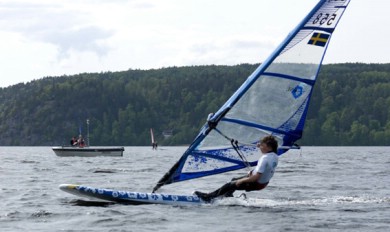
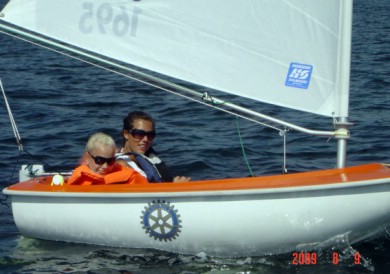
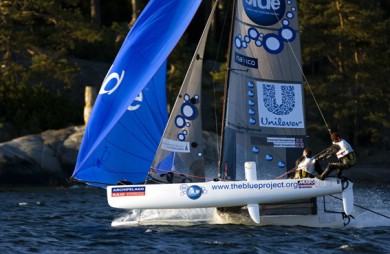







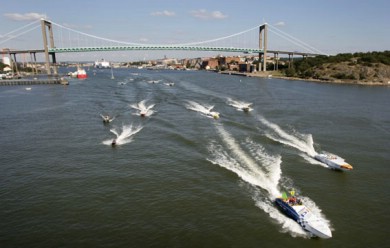



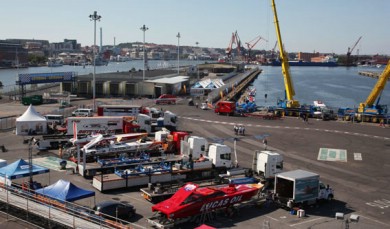
.jpg)
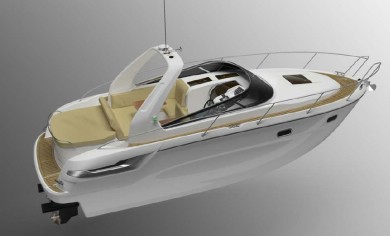
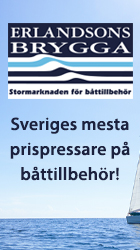
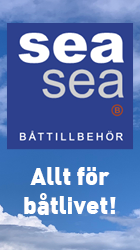
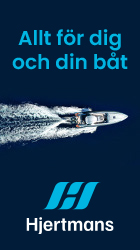

Kommentarer
Har idag besökt Göteborg för att se Havets Grand Prix, och måste tyvärr konstatera att det var den i särklass sämsta motortävling jag besökt sen jag var med farsan på biltävling första gången 1965.
Betalade 175:-/ per person i Frihamnen för att få se lite depåarbete innan start. Det första man erbjuds är en hamburgare för 80:- + dricka 25kr. Det kan man väl leva med , men när man därefter går ner mot vattnet för att beskåda dessa båtarnas formel 1 stoppas man av en ordningsvakt som förkunnar att jag har minsann inget tillträde till detta område. Dom få betalanda åskådare som var där var samtliga minst sagt förbannade över detta och ifrågasatte vad vi hade betalt inträde för.
I priset ingick resa med spårvagn till tävlingsområdet vid Oscar II fort. Vi fick dessvärre ingen information om var vi skulle kliva av spårvagnen, bara att från Brunnsparken kunde man ta 7 eller 11. Vi hamnade nu på Saltholmen efter ca 50 minuters spårvagnresa utan fungerande ventilation.
När vi väl kom fram dit fick vi fram av någon badgäst att vi skulle stigit av 2 hållplatser tidigare. Tillbaka igen efter en snabbfika på Saltholmens Cafe som piggade upp oss litegrann och steg av på 2:a hållplatsen från Saltholmen.
Letade oss ner mot havet och kom till Räddningstjäntens anläggning. Såg några båtar som körde runt lite utanför hamnen och frågade tillslut en av killarna från räddningstjänsten hur vi skulle ta oss till Oscar II Fort men han var inte säker på hur man tog sig dit, dom använde alltid GPS vid utryckning……..
Efter att vi gått tillbaka till spårvagnen och åkt ytterligare 2 hållplatser kom vi till slut till K4:as kasernvakt som gav oss en väldigt diffus vägbeskrivning, och efter ca 3 timmars spårvagnsresor och promenerande över i stort sett hela Långedrag kom vi äntligen fram till Oscar II Fort och publikområdet. Jag räknade till hela 15 st som hade hittat dit och när vi anlände startades högtalaranläggningen upp med med sändningar från Bandit Rock, äntligen började det se ut som om denna dag inte skulle bli helt misslyckad. ca 16.10 kom det då en båt körandes utanför fortet och efter 1 minut yterligare en.
Högtalarsystemet var nu helt tyst så någon som helst information om hur kvalificeringracen gick fick vi inte.
Är inte säker på om vi såg 6 eller 8 båtar köra förb innan det blev stopp vid 5 tiden. Vi gav upp och började gå tillbaka mot spårvagnen för transport mot frihamnen och den parkerade bilen. Har lovat mig själv att aldrig mer åka på något P1 båtrace ever!!!